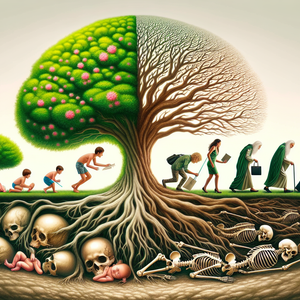The Rise of the Hybrid Actuary: Bridging Human Insight and Machine Power

For centuries, actuarial work has been defined by its reliance on rigorous statistical and mathematical methods. Actuaries have historically applied these skills to assess risk, calculate premiums, and model financial outcomes. However, the advent of advanced technologies like machine learning, big data analytics, and AI-powered algorithms has revolutionized how tasks are performed. Where once actuaries painstakingly analyzed historical data to project future outcomes, they can now rely on sophisticated software to complete such analyses in a fraction of the time. For example, calculating the future liabilities of a pension fund—a process that could previously take days—can now be done in minutes using AI-driven tools. Despite this newfound efficiency, fears that machines will render actuaries obsolete are unfounded. While AI and automation excel at processing vast datasets and performing repetitive tasks, they lack the ability to interpret results with nuance, apply ethical judgment, or address ambiguous scenarios. These are areas where human actuaries shine, and hybrid actuaries take this a step further by pairing their human expertise with technological capabilities. The hybrid actuary, therefore, is not a replacement for traditional actuaries but an evolution of the role—one that uses technology as a complement rather than a competitor.
Skills for the Hybrid Actuary
The emergence of the hybrid actuary has redefined what it means to excel in the profession. To thrive in this new paradigm, actuaries must cultivate a unique blend of traditional expertise and technological proficiency. Below are the key skills that define the hybrid actuary: 1. Technical Proficiency in Data Science and AI: The hybrid actuary is as comfortable with programming as they are with probability theory. Proficiency in languages like Python, R, or SQL is essential, as is familiarity with machine learning frameworks such as TensorFlow and Scikit-learn. These technical skills enable hybrid actuaries to build predictive models, automate processes, and analyze unstructured data. Real-World Example: In insurance, hybrid actuaries are using AI algorithms to predict customer churn rates and identify fraudulent claims. By analyzing patterns in vast datasets, they can provide actionable insights that traditional methods simply cannot uncover. 2. Critical Thinking and Ethical Judgment: Machines are powerful tools, but they lack the ability to evaluate outputs against ethical considerations or broader business goals. Hybrid actuaries excel at interpreting machine-generated insights and applying critical thinking to make informed decisions. Real-World Example: A hybrid actuary might use AI to recommend pricing strategies for an insurance product but also consider whether the algorithm’s suggestions align with regulatory frameworks or ethical principles, such as fairness to policyholders. 3. Communication and Storytelling: In a data-driven world, technical analysis is only valuable if it can be communicated effectively. Hybrid actuaries are skilled at transforming complex data into compelling narratives, often using visualization tools like Tableau or Power BI to present findings. Real-World Example: When presenting a climate risk assessment to executives, a hybrid actuary might use interactive dashboards to illustrate the potential financial impact of extreme weather events, making the data accessible to non-technical stakeholders. 4. Adaptability and Lifelong Learning: Technology evolves at a breakneck pace, and staying relevant requires a commitment to continuous learning. Hybrid actuaries are adaptable, constantly updating their skills to keep pace with emerging trends, from new regulatory frameworks to advancements in AI. Real-World Example: A hybrid actuary might attend workshops on blockchain technology to better understand its implications for insurance contracts, or enroll in online courses to master the latest machine learning techniques.
Real-World Applications of the Hybrid Actuary
The impact of hybrid actuaries is already being felt across diverse industries. Their ability to combine actuarial expertise with technological acumen is unlocking new possibilities, particularly in areas that were once beyond the reach of traditional methods. Insurance: Hybrid actuaries are using telematics data—collected from vehicles via GPS and sensors—to create usage-based insurance models. These models reward safe driving behavior with lower premiums, a win-win for both insurers and policyholders. Healthcare: In healthcare, hybrid actuaries analyze patient data to predict future claims and design more efficient insurance products. By identifying high-risk individuals, insurers can also implement preventative measures to reduce costs. Climate Risk Modeling: Hybrid actuaries are leveraging real-time data from satellites, IoT sensors, and climate simulations to improve risk assessments. Unlike traditional methods, which rely on historical data, these models can adapt dynamically to changing conditions, providing more accurate forecasts. Finance: In financial services, hybrid actuaries use AI to simulate market scenarios and stress-test portfolios, enabling institutions to make more informed investment decisions.
The Challenges of Becoming a Hybrid Actuary
While the hybrid actuary represents an exciting evolution of the profession, the transition is not without challenges. Upskilling: Many seasoned actuaries may find the prospect of learning programming or AI daunting, particularly if their careers were built on traditional methodologies. Organizations can address this barrier by offering training programs and mentorship opportunities to support employees. Ethical Dilemmas: As reliance on AI increases, so does the potential for ethical challenges. Hybrid actuaries must grapple with questions of algorithmic bias, transparency, and accountability, ensuring that AI-driven tools are used responsibly.
The Future of the Hybrid Actuary
Looking ahead, the hybrid actuary is poised to become a cornerstone of the actuarial profession. These professionals will not only enhance organizational decision-making but also play a key role in shaping how technology is integrated into risk assessment and financial modeling. At its core, the rise of the hybrid actuary underscores the enduring value of human ingenuity. While machines can process information with unparalleled speed, they lack the creativity, empathy, and judgment that define human decision-making. By combining the best of both worlds, hybrid actuaries are uniquely equipped to navigate the complexities of a tech-driven future.
The actuarial profession stands at the threshold of a transformative era, one in which technology and human expertise converge to create new possibilities. The hybrid actuary is at the forefront of this change, redefining what it means to assess risk, solve problems, and create value. For those willing to embrace lifelong learning and adapt to the demands of a rapidly evolving landscape, the future is bright. In a world increasingly reliant on AI and automation, the hybrid actuary exemplifies the irreplaceable value of human insight. Far from being a relic of the past, the actuary of tomorrow is a dynamic, tech-savvy professional ready to lead the charge into a new era of innovation and opportunity.
Machine Learning Actuary
insurance companies (e.g., Allstate, AXA), consulting firms (e.g., Deloitte, Milliman)
Responsibilities
Develop predictive models using machine learning frameworks like TensorFlow, Scikit-learn, or PyTorch to optimize risk assessment and pricing strategies.
Collaborate with data scientists to analyze unstructured data (e.g., telematics, social media trends) for insurance or financial applications.
Stay updated on AI advancements to integrate new methodologies into actuarial workflows.
Climate Risk Analyst (Actuarial Focus)
reinsurance companies (e.g., Swiss Re, Munich Re), environmental consulting firms, or government agencies
Responsibilities
Use real-time data from satellites, IoT sensors, and climate models to assess environmental risks and their financial implications.
Model the impact of extreme weather events on insurance portfolios and infrastructure investments.
Communicate findings to stakeholders using visualization tools like Tableau and Power BI.
Healthcare Data Actuary
health insurance companies (e.g., UnitedHealth Group, Cigna) or healthcare-focused tech startups
Responsibilities
Analyze patient and claims data to predict future healthcare costs and improve insurance product design.
Collaborate with healthcare providers to implement preventative measures for high-risk individuals, leveraging data analytics.
Ensure that pricing strategies comply with regulatory frameworks and ethical considerations.
Blockchain Risk Consultant
consulting firms (e.g., PwC, EY), fintech startups, or blockchain-specific companies
Responsibilities
Assess the implications of blockchain technology on insurance contracts, such as smart contracts for automated claims processing.
Develop frameworks to quantify operational and financial risks associated with cryptocurrency and decentralized finance (DeFi).
Stay updated on emerging blockchain trends and regulatory changes affecting the insurance and finance sectors.
AI Governance Specialist for Actuarial Models
large insurance companies (e.g., Prudential, MetLife) or regulatory bodies like NAIC
Responsibilities
Oversee the development of AI-driven actuarial models to ensure compliance with ethical and regulatory standards.
Identify and mitigate algorithmic biases in pricing, claims, or underwriting decisions.
Develop guidelines for transparent model documentation and accountability in AI-driven decision-making.


